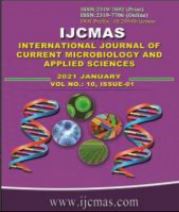


 National Academy of Agricultural Sciences (NAAS)
National Academy of Agricultural Sciences (NAAS)

|
PRINT ISSN : 2319-7692
Online ISSN : 2319-7706 Issues : 12 per year Publisher : Excellent Publishers Email : editorijcmas@gmail.com / submit@ijcmas.com Editor-in-chief: Dr.M.Prakash Index Copernicus ICV 2018: 95.39 NAAS RATING 2020: 5.38 |
The present study on impact of organic, inorganic and integrated nutrient management practices on carbon pool and nutrient availability of perennial, annual and seasonal crops was studied during 2019-20. The total four villages were selected for study. The surface (0-15 cm) and sub-surface (15-30 cm) soil samples from each field were collected after harvest of Nagpur mandarin, Pigeonpea and Paddy. The total of 72 (surface and subsurface) samples were collected. The results revealed that, Addition of organic matter lowered the soil pH, increased residual organic C and available N, INM increased available S, inorganic fertilizer increased available P and K compare to organic and INM farming practices. INM resulted in the improvement of most soil physico-chemical properties and nutrient balances that lead to increased and sustained production. Under conventional management, the agronomic relevance of SOM with regard to nutrient supply is much lower than under organic. The highest very labile carbon, labile carbon and less labile carbon was observed under the regular addition of organic fertilizers like FYM in case of Nagpur mandarin and non-labile carbon under the use of inorganic fertilizers. The lower values of CVL, CLand CLL were registered where the use of inorganic sources takes. It was observed that the non-labile carbon was lowest under integrated nutrient management practices. Active pools are highest in organic and INM practices and passive pool is found abundant where inorganic sources were used.
 |
 |
 |
 |
 |